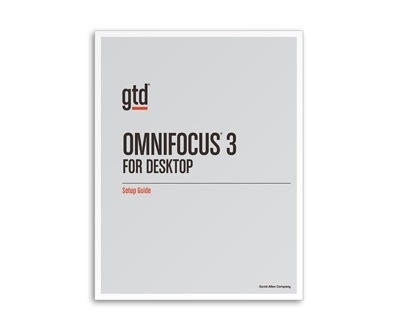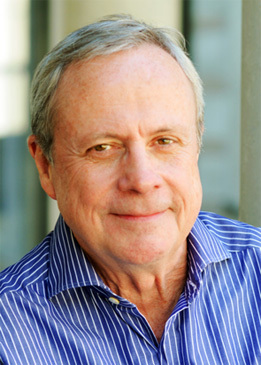David Allen's Blog, page 37
December 21, 2018
GTD & OmniFocus 3
 New GTD & OmniFocus 3 Setup Guide
New GTD & OmniFocus 3 Setup GuideWe are excited to announce the release of a new GTD Setup Guide for OmniFocus 3. Given the significant changes in this new release, we’ve overhauled our Setup Guide specifically for version 3.
This Guide will show you how to:
– Understand the fundamental GTD best practices
– Optimally configure OmniFocus in the way we have found works best for GTD
– Configure and populate your projects and link them to the related Next Actions
– Configure and populate your Next Actions
– Use the Inbox to capture your Mind Sweep items
– Integrate email into your OmniFocus workflow
– Create useful reference lists
… and much more.
Get the Guide
Download a sample or purchase the Guide from our online shop.
If you’re an OmniFocus 2 user, check out our GTD Guide for your version here. We also have GTD Guides for many other popular software tools here.
The post GTD & OmniFocus 3 appeared first on Getting Things Done®.
December 13, 2018
How to Balance Meetings and Work

Along with email volume, the overabundance of meetings is the major complaint of knowledge workers today.
That said, meetings can be extremely effective and are even critical to getting meaningful work done. It would be an interesting experiment to cancel all meetings and watch what happens. What would we miss? What negative impacts would there be? What opportunities would go unrecognized?
What’s the purpose?
Such an experiment would give us insight into what constitutes a constructive and valuable meeting. Just imagining the experiment reveals the key component of effective meetings: purpose. An essential question to answer at the start of any meeting is, “What do we want to accomplish here, and by what time?” If purpose isn’t clear, no one has sufficient criteria by which to frame and monitor the ensuing conversation, nor the information to know whether he or she should participate in it. So, step one, make sure the purpose of each meeting is clear.
Assuming the purpose of a meeting is clear, the second factor to consider is this: What’s your purpose in being there? What is your job? What are your roles and responsibilities within it? How does the meeting relate to that context? If the meeting truly relates to or involves your responsibilities, step up and play. If it doesn’t, step up and decline.
Given that many companies strive for collaborative cultures, I know it might seem a brazen act of rebellion and defiance to decline a meeting request. But before you agree to attend, take two minutes to identify the purpose of the meeting and why you’re expected to be there. You can frame such a query as elegantly and politely as, “I like to contribute as best I can in meetings, so it would help me to gain a sense of the desired outcome of the meeting, and whether and how I can serve that outcome.”
If the meeting’s purpose is clear, it should be clear whether your involvement is necessary. If not, you can gain clarity by further probing. Approach these conversations with the intent of contributing value to meaningful meetings rather than ducking meetings altogether. By seeking clarity and striving to be effective with how you spend your time, you may influence your colleagues to do the same and help your organization expend resources more efficiently.
Best practices for meetings
There are many best practices for good meetings, which include having an agenda, having a monitor ensure the agenda is adhered to, keeping track of decisions and next actions (and by whom), granting everyone opportunity to speak, and having sufficient breaks (if the meeting is longer than ninety minutes). But the critical foundation is clear purpose—for the meeting and your role therein.
Meetings are indispensable when you don’t want to do anything.
—J. K. Galbraith
Meetings and Email
Ineffective meetings contribute to other ineffective habits, like time-wasting emails. “I wasn’t sure what we decided at the project meeting in terms of our go-forward strategy. Could someone clarify that for me?” Ineffective emails contribute to ineffective meetings. “We need to meet again to clarify what our last meeting was about and who will do what by when.” And the more you permit either behavior, the deeper the quicksand pulls you down.
If your meetings are not ending with a collective sigh of, “Wow. Good meeting!” some course correction is due. Start by clarifying purpose with the intent to effectively contribute value and see what happens.
–David Allen
This essay appeared in David Allen’s Productive Living Newsletter. Subscribe for free here. For more GTD tips on meetings, check out www.gtdconnect.com.
The post How to Balance Meetings and Work appeared first on Getting Things Done®.
December 12, 2018
Episode #46: Seamless Completions and Fresh Perspectives
David Allen and Coach Kelly Forrister present an instructional GTD webinar where you’ll have the opportunity to take a deeper dive into understanding the power of completion and creating a vision for wild success.
Subscribe or Download to GTD Podcasts
iTunes
Stitcher
Libsyn
Google Play Music
Spotify
SoundCloud
The post Episode #46: Seamless Completions and Fresh Perspectives appeared first on Getting Things Done®.
December 5, 2018
The GTD Horizons of Focus® for determining your priorities
David Allen defines “work” from at least six different horizons, corresponding to different altitudes of perspective.

The GTD Horizons of Focus
HORIZON 5: Purpose and Principles
HORIZON 4: Vision
HORIZON 3: Goals and Objectives
HORIZON 2: Areas of Focus and Accountability
HORIZON 1: Projects
GROUND: Calendar/Actions
Your priorities are determined from the top down—i.e. your purpose and values will drive your vision of the purpose being fulfilled, which will create goals and objectives, which will frame areas of focus and accountability. All of those will generate projects which will require actions to get them done.
The post The GTD Horizons of Focus® for determining your priorities appeared first on Getting Things Done®.
November 26, 2018
How do I get other people to do GTD?
 Question: How do I get other people to do GTD?
Question: How do I get other people to do GTD?
David Allen’s answer: Getting other people to do GTD is really about: How do we effectively communicate? How do we not have to have ambiguous non-decisions made about stuff? So, if nothing else, make sure you have your own GTD system in practice and let everybody else know how to engage with it.
For example, a simple one to implement is letting everybody know where your in-tray is on your desk for new input. And if they have something you need to see, and you’re not around, that’s exactly where it goes—nowhere else. In other words, don’t let them use anything else, like putting sticky notes on your computer screen, or notes on your chair, or whatever else people do. You can also train them to stop interrupting you when they have something they need to give you. If they trust you’ll see it in that designated in-tray (because you’re emptying it regularly and tracking your commitments from what you process), they start to use it instead of yanking on you to make sure you “see” what they want to make sure you see.
For more resources on implementing GTD for teams, visit GTD Connect.
The post How do I get other people to do GTD? appeared first on Getting Things Done®.
November 21, 2018
The Strategic Value of Clear Space
 Are neat people more productive?
Are neat people more productive?How easily you can make a mess is how truly productive you can be. Maximum freedom to generate and play around in creative chaos is the optimal condition for constructive thinking and work.
This is true on a project, in the kitchen, in your office, and at your writing table—anywhere and anytime you want to get real work done.
I don’t usually work in a neat fashion. Whether I’m writing an essay, arranging flowers, or making guacamole, I wind up strewing stuff all over the place. If you were to walk into my office while I was working or thinking about something, you’d likely see notes, books, and files strewn around somewhat randomly; a mindmap on my computer screen; doodles and words scrawled on my whiteboard. When I really get involved in something and my creative juices start flowing, it’s likely to look like something exploded in the middle of it. I have a singular focus, but it doesn’t seem orderly until it’s done. My best work happens that way. Yours will too.
The freedom to make a mess
But if you’re already in a mess, you’re not free to make one. If you have a desk piled with unfinished, unclear work; if you’re trying to repair something in your garage with tools and incomplete projects strewn everywhere; if you’ve got thousands of unprocessed emails in your inbox; or if you’ve just got a lot of issues and situations in your life and work on your mind—you’re going to be laboring under a serious handicap.
That’s why, when I’m not doing anything else, I’m cleaning up. I’m getting my inboxes to zero, getting my desk in order, clearing off the kitchen counter. I’m also capturing, clarifying, and organizing stuff that’s pulling on my attention. There’s an event, a problem, an opportunity coming toward me I can’t see yet. Something will emerge that I will need to focus and work on, coming from the outside or from my own inspiration. When that happens, I want to be ready. Things will get messy, but they will neither start nor end that way.
Begin in a clear space
To tackle something most productively you must begin in clear space. Physically you need all your tools in order and an open space for spreading your raw elements and assembling structures. Psychically you need an empty head, clear of distractions and unfinished business holding your attention hostage. From this starting point you will have your best chances for creative thinking, optimal ability to deal with surprise, maximum flexibility to come up with workarounds and innovative solutions. You’ll be able to take advantage of serendipitous, potentially valuable ideas.
If you have a problem to solve, limited resources to allocate, or an ambiguous situation to clarify, you’ll want to work from a clear deck. You are most productive when all of your available resources are present and accounted for, unencumbered with irrelevant pressures and dross, with an ability to apply relaxed but concentrated focus.
Zen practices refer to a “beginner’s mind.” The ready state for enlightenment is a consciousness devoid of preconceptions. Much of the training in the esoteric spiritual disciplines is concerned with de-conditioning the psyche, allowing the full experience and awareness of what’s fundamentally true in the present, without the illusory colorings brought on by interpretations from the past or projections into the future.
That’s the best place to come from—mentally, emotionally, and psychologically—if you’re developing the agenda for the staff meeting, formulating the best way to approach your boss about the delay in a major project, restructuring your board of directors, or planning the family vacation.
This is not a state from which most people live and work.
How do you get to clear space?
So, how do you get to that clear place? Can you only achieve it by dedicating years of disciplined asceticism on a Tibetan mountaintop? That’s one way, but there’s a nice shortcut.
In your physical space it’s pretty simple—just put stuff where it belongs.
In your psychic space it’s also pretty simple (though often quite subtle): you merely have to find out why things are on your mind, and eliminate the cause. Why are you distracted? What causes your mind to be unclear and inappropriately filled with unproductive thinking that makes no progress on what you’re focused on but which creates stress and disturbance that undermines your energy and focus? The basic cause is some decision you haven’t yet made and/or you haven’t parked the resulting contents into a trusted system.
“Mom” will only be on your mind if there’s something current going on in your relationship with her (her birthday? her health issue?) about which you haven’t clarified what outcome, exactly, you’re committed to achieve or what you’re specifically going to do about it as a next step to making that happen. And even if you’ve already clarified those points precisely, if you haven’t put the reminders of that outcome and that action step in places you know you will review at the right time, you’ll still have it impinging on your consciousness.
That’s going to be equally true about your son’s college choice, the status of your retirement account, your choice about hiring a new executive assistant, and your company’s strategic direction.
The bottom line
Decide the outcomes you’re committed to. Decide the next physical, visible actions required to move toward them. Place reminders of all of that where you know you’ll look at the right time. Keep everything in your life and work that way—clear, current, and complete. Discover the strategic value of clear space. Get ready to make a mess.
This essay appeared in David Allen’s Productive Living Newsletter. Subscribe for free here.
The post The Strategic Value of Clear Space appeared first on Getting Things Done®.
November 20, 2018
Episode #45: Dealing with Competing Priorities
Do you ever struggle with managing competing priorities and don’t know how you’ll get it all done? Join David Allen for a conversation that’s packed with practical GTD coaching advice on how to deal with competing priorities–from getting a higher perspective on your life and work, down to trusting your moment-to-moment action choices.
Listen Now—Dealing with Competing Priorities
Subscribe or Download to GTD Podcasts
iTunes
Stitcher
Libsyn
Google Play Music
Spotify
SoundCloud
The post Episode #45: Dealing with Competing Priorities appeared first on Getting Things Done®.
David Drake’s GTD Story
 Tell us a little about yourself:
Tell us a little about yourself:
My name is David Drake, MS, PhD. I am a professor of microbiology & infectious diseases. I am in the Iowa Institute for Oral Health Research, College of Dentistry, University of Iowa.
How did you hear about GTD?
When I became an Assistant Professor many years ago, I realized that my old methods of keeping on top of everything were not working. I was in a Barnes & Noble bookstore one afternoon and looking at the business books to find a new approach. I spotted David Allen’s book and was quite intrigued. I think the first edition of the book had just come out.
How long have you been practicing GTD?
Well, that was in 2003-4, so at least 15 years now.
How has GTD made a difference in your work and life?
I finally have a comprehensive approach to get all of the stuff coming at me processed, defined, and into a trusted system. This allows me to be more creative doing my deep work.
What areas of GTD are you doing really well (or at least better than you used to)?
Processing all of my inboxes, maintaining my actions and projects lists are all things I feel I am doing very well.
What areas of GTD would you like to get even better at doing?
Finding a new approach to doing my Weekly Reviews. I think I need to leave and go somewhere besides my office. I have not tried that, but I think that will significantly improve my Weekly Review process.
What is one piece of advice you would give to someone just starting out with GTD?
I have studied productivity systems for over 30 years now. GTD is the cornerstone of all that I do. It takes time to learn, but it WILL change your life. But you also have to personalize it to fit your personality and style. One size does not fit all, but the principles behind the GTD process really do! Find a mentor who can work with you. I am always willing to help others.
The post David Drake’s GTD Story appeared first on Getting Things Done®.
November 2, 2018
When did email become my job?
 Question: At what point did answering e-mail become my job?
Question: At what point did answering e-mail become my job?
David Allen: Well, at what point did answering anything—your mail, having conversations in your hallway—become your job? It’s all your job. You just have to decide what your work is. As the late, great Peter Drucker said, that’s your biggest job, to define what your work is.
So how do you define what your work is, and therefore should you be doing that? The good news about this overwhelm is that it’s forcing people to make executive decisions that they never felt like they had to make before. “I need to do everything that comes my way.” No, you can’t anymore, sorry. You are going to have to do triage. That means you are going to have to have a conversation with your boss. You are going to have to show up with a list of everything he or she has given you and have a conversation. “Gee, thanks for these new things, can we talk? Because I am not going to be able to do them all.” It’s forcing those kinds of conversations.
That’s why people have this attraction/repulsion to GTD. It ain’t lightweight stuff. If you are really going to work this, that’s what’s going to start to show up.
The post When did email become my job? appeared first on Getting Things Done®.
October 29, 2018
What should you do?

With many choices you are given moment-to-moment, what should you do? There are five steps in the Mastering Workflow model of GTD®: Capture, clarify, organize, reflect, and engage. So which step is most important? How do you decide whether to collect stuff, process an inbox, organize your work, reflect on all of your choices, or just do something? The decision comes back to a key concept in the Getting Things Done® methodology:
What most has your attention?
Is any one of those five stages more critical than another? It depends. And, it will change moment to moment. You may have a lot of unprocessed emails piling up in your inbox, but there may be some action you should be taking that’s more important than getting IN to empty. At times, organizing more effectively or differently will take precedence. And certainly there are times when the priority is to step back and reflect on the total inventory of your work.
If you’re not sure which of these processes you should pursue in the moment, I’d recommend cleaning up your inboxes and reducing your backlog toward zero.
A few good reasons:
It helps clean up residual stuff needing decisions so you can think more clearly.
It ensures that all the options about what you could be doing are evident in front of you.
It serves as preventive maintenance so that you can be ready for new stuff coming toward you that you can’t foresee.
It’s usually rather fun and freeing to be playing a part of the game that you know you can win by cleaning up, making progress, and generating creative and productive ideas along the way.
The Solution
So when in doubt, clean an inbox. Then see what you really feel like doing.
This essay appeared in David Allen’s Productive Living Newsletter. Subscribe for free here.
The post What should you do? appeared first on Getting Things Done®.
David Allen's Blog
- David Allen's profile
- 1484 followers



